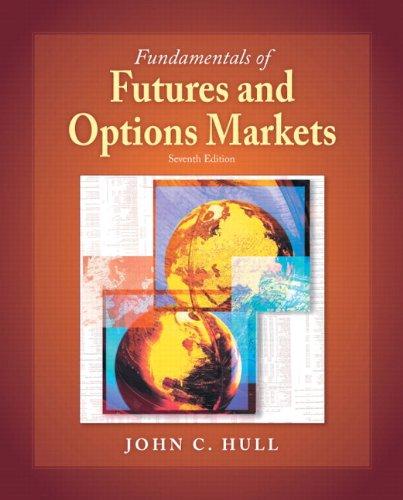Question
Cost - of - Carry (Contango) Futures Contango Trading Simulation #2 F2 Being the resourceful person that you are, youve made some inquiries into the
Cost - of - Carry (Contango) Futures Contango Trading Simulation #2 F2
Being the resourceful person that you are, youve made some inquiries into the cost of storage for crude oil and have been quoted a price of $0.10 per day per barrel. In addition, the market is currently exhibiting historically low interest rates of zero percent. Therefore, our trading scenario is simplified with three assumptions: 1) there are no financing or interest costs 2) convenience yield is zero, and 3) time is discretized into single days since you must pay for your storage on a daily basis.
Expressing the time scale as days instead of years, the arbitrage-free pricing equation for this trading case is: 0 = 0 + .
You believe that by using this pricing relationship, you can generate arbitrage profits by trading the basis spread between the futures and the physical market. Since you have observed that the cost of storing a barrel of crude oil is 10 cents per day, the futures contract should trade at premium of ($0.10 * # of days to settlement) over the spot market price. If it doesnt, you can generate profits by selling the futures contract (committing to delivery of physical at a specified price) and buying the spot crude oil.
Your goal is to observe the market and determine whether arbitrage opportunities exist. If the opportunities present themselves, you should arrange necessary storage and execute the required trades in order to generate arbitrage profits. As youre working at your computer and calculating the appropriate prices, you get a suggestion from a peer that you can build a real-time-linked Excel spreadsheet to calculate the arbitrage relationship in real time. To do so, you are advised to drag & drop fields of data from the Portfolio window directly into an open Excel sheet.
In this trading simulation, you can purchase or sell futures contracts on crude oil (CL-1F). You can also trade physical crude (spot crude). The futures contract is a commitment to take or make delivery at the end of the 1-month trading period. At the end of the month, the contract will settle and if you are long (short), you will need to take (make) delivery of crude. Each contract represents 1000 barrels of crude oil.
The spot market for crude (CL) trades as individual barrels which means purchasing 1 unit of CL will result in owning 1 barrel of crude oil. Storage tanks are available to be leased at any time. These containers each hold a maximum of 10,000 barrels of crude oil. The cost for leasing a storage tank is $1000 per day. Each participant can lease up to 20 storage tanks at the same time.
The case represents 1 month (20 trading days) of time, and that month is simulated over 5 minutes (=300 seconds) of trading time. Therefore, 1 trading day is simulated over 15 seconds (=300 seconds / 20 trading days).
Each student will be subject to gross and net trading limits. The gross trading limit reflects the sum of the absolute values of the long and short positions across both the futures and the spot contracts; while the net trading limit reflects the sum of long and short positions such that short positions negate any long positions.
Net Trading Limit 1,000,000 units of the underlying Gross Trading Limit 10,000,000 units of the underlying
For example, if you short 1 contract of CL-1F and buy 1,000 barrels of CL spot, your Net Trading Limit will be zero while your Gross Trading Limit will be 2,000. There are no transaction costs.
Once the case is over, the instructor may process your transaction results to understand the source of your P&L. Since any transactions unrelated to the arbitrage opportunities will be considered speculative in the case, your overall P&L will be decomposed to two categories P&L from arbitrage and P&L from speculation.
Once your transaction results are processed, your performance will be ranked based on the following equation:
& for ranking = & from arbitrage + min (0, P&L from speculation)
In other words, if you generated a profit from speculation, only the P&L from arbitrage is used for ranking. However, if you generated a loss from speculation, it will be included in the P&L calculation for ranking in order to discourage you from speculating.
Question:
- What was the impact of the bid-ask spread on your arbitrage calculation?
- How could (or did) you take advantage of futures prices that were below the no-arbitrage futures price?
- How did the fixed cost of storing oil impact your arbitrage trading decision?
- Were your arbitrage trades profitable at every point in time during the case? Why or why not?
- Did you hold your arbitrage positions until the end of the case? Was it the optimal strategy? Why or why not?
Step by Step Solution
There are 3 Steps involved in it
Step: 1

Get Instant Access to Expert-Tailored Solutions
See step-by-step solutions with expert insights and AI powered tools for academic success
Step: 2

Step: 3

Ace Your Homework with AI
Get the answers you need in no time with our AI-driven, step-by-step assistance
Get Started


